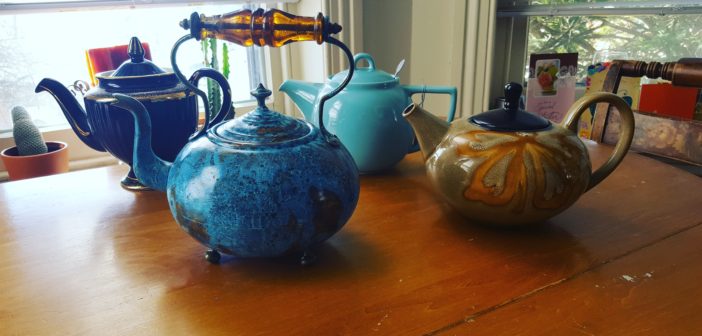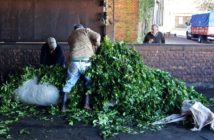What is tea without a teapot? As a historical artifact, the teapot is as important to the enjoyment of tea as the leaf itself. Teapots were invented and first used in China and the design is said to be based on the Chinese wine ewer.
Most historical accounts agree that it was during the Ming Dynasty (1368-1644) around 1500 that significant use of clay teapots came into production. Stoneware teapots were in production at this time in Yixing (pronounced yeeshing) potteries.
Some early Yixing teapots shape retained a similar likeness to the wine pot. During this time, loose leaf tea became the preferred form of tea which helped advance the production of teapots. Prior to this tea was infused from bricks or powders.
Before Loose Leaf Tea
The traditional method of making tea prior to the use of teapots was either brewed in open pans or prepared in the actual cup by whisking a paste made from powdered tea.
In ancient China, ground or whole tea leaves were compressed into a mold forming a tea brick. This made the tea easy to transport and was commonly used as currency in trading. Pieces of the tea were broken from the tea brick and boiled in kettles or pots.
Powdered teas became popular by the Song Dynasty (960-1279). Powdered tea was placed in cups and whipped or whisked as boiling water was poured over it. Similar to the Japanese tea ceremonies of today.
Form Follows Function
In The Tea Lover’s Treasury, James Norwood Pratt writes, “The teapot has not always been the undisputed lord of the tea service; historically the teacup comes first.”
But with the proliferation of loose leaf tea during the Ming Dynasty, the earliest examples of teapots are seen much as we know them today. Teapots from this period were made of purple clay from the Yixing region of China.
Noted potters had been using the Yixing clay in pottery since the Song Dynasty (960-1279). The finished stoneware is usually brown or red in color and is left unglazed.
The Most Famous Teapots in the World
The Yixing is named after a city in the Jiangsu Province of China where the color of the pots is due to the local iron ore. The Yixing is considered by some as the first “official” teapot.
During the Song Dynasty (1271-1368) the production of ceramics was expanding. Towards the end of the Song Dynasty teapots began to appear. These early teapots were made from unglazed zisha, or purple sand clay, and evolved from the shape of tall handled wine pots or water ewers.
Tea was consumed in small quantities during this time so the teapots were small. Teapots were given a lid to maintain the flavor of the steeped tea when the steam remained in the pot. Handles were added to the side for ease of lid removal.
The Yixing clay teapots were hand formed and carved. The properties made it ideal for brewing tea. The unglazed clay absorbed the flavors and aromas of the tea seasoning the pot after many uses. For this reason, each teapot is dedicated to a specific tea type. The small size made them ideal for individual use.
Thanks to the high iron content, the zisha clay became a very practical choice for the teapot as it tolerates near boiling water without cracking. The color doesn’t fade nor does the clay retain any color or odor. The tight lids retain the aroma while the zisha clay keeps the tea warm for longer periods compared to porcelain.
With repeated use, the surface develops a fine patina. Carefully maintained, they can last a lifetime.
Fast Forward 500 Years Later
Yixing teapots are coveted to this day and remain China’s gold standard for brewing vessels. The city of Yixing, in Jiangsu Province, continues to produce this famous teapot.
Zisha clay is a natural resource obtained from red ore deposits from the two mountains surrounding Yixing. So much ore is being mined, a law was passed in 2006 to protect over mining of the ores.
Pottery artisans are revered for their precision and the teapot craft is very competitive. Artists are required to take a certification of which there are seven levels. The top level is a national certification that only 12 people can hold at one time.
Each handcrafted pot must adhere to specific parameters generally taking four days from start to finished teapot. Everything must fit precisely, the top of the spout and handle need to be level with the lid. The teapot is tested for its functionality measuring how smoothly the tea pours from its spout.
“Every teapot has a soul” – Yixing tea potter Ping Yu
How You Can Use This Information Today
There are four levels of Yixing teapots you can purchase today in terms of quality:
- Basic simple wares are produced in the largest factories and sell for around $15.
- Standard production pots with a little more design sell for around $60.
- Collectors pots crafted by well know potters sell for around $150 to $800 a piece.
- Antique Yixing teapots made by master potters are highly collectible selling for anywhere from $3,000 and up.
The factory produced Yixing teapots are made in molds while artisan made teapots are crafted by hand. The handmade pots have seams in the interior. This is because potters cut out rectangular sheets of clay and seal them together to make the main body. Then the spout, lid, and handle are joined to the body. Pots made from a mold will not have a seam.
No matter the price point, the teapot made from true Yixing clay will serve you well. Yixing teapots are primarily used for brewing black, oolong and Pu-erh teas. They are not used for brewing green teas.
Sources:
The New Tea Lover’s Treasury by James Norwood Pratt
The Book of Tea by Okakaura Kakuzo
Tea: East and West by Robert Faulkner
The Story of Tea by Mary Lou Heiss and Robert J. Heiss
In China’s City of Yixing, Everyone Is Fluent in Pottery by Clarisa Wei on Eater.com
The Evolution Of Tea Sets From Ancient Legend To Modern Biometrics – by Tove Danovich for Tea Tuesdays The Salt on NPR.org
About the Author:
 Mary Ann Rollano is an award-winning tea entrepreneur. You can find her blog at Life Is Better With Tea, where you can learn how to select, brew and even create recipes with tea.
Mary Ann Rollano is an award-winning tea entrepreneur. You can find her blog at Life Is Better With Tea, where you can learn how to select, brew and even create recipes with tea.



